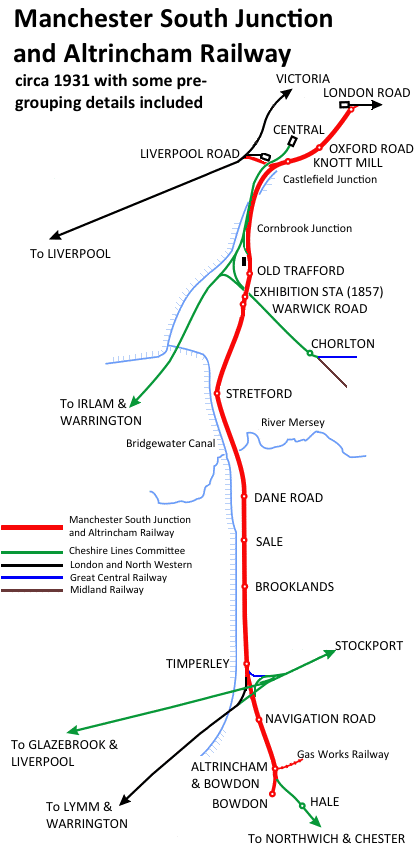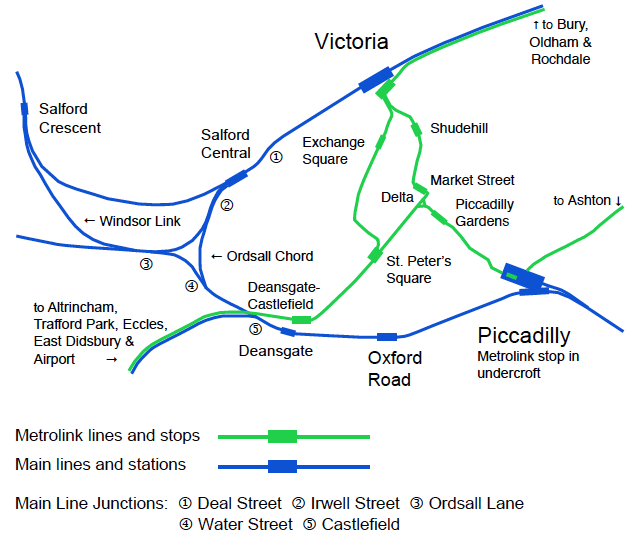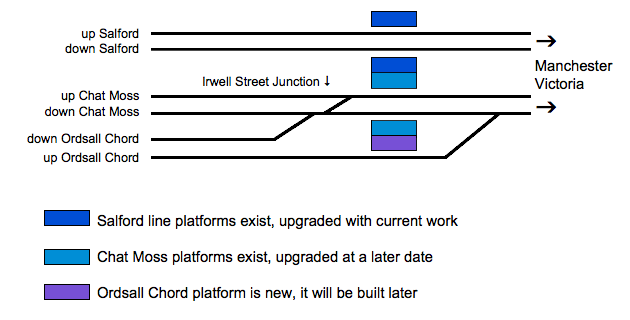
 |
Altrincham Electric Railway Preservation Society |
These pages are a very brief history of the line.

By the 1820s Manchester was a thriving town based on the cotton and related industries. Most of the raw cotton was imported and finished goods exported through Liverpool docks. Road and canal links were considered inadequate. A group of Liverpool businessmen got together and promoted the Liverpool and Manchester Railway. The line opened on 15th September 1830. Its Manchester terminus was Liverpool Road Station which is now the Manchester Museum of Science and Industry. From the mid–point of this line; the Grand Junction Railway opened in 1837 linking it with Birmingham.
The Manchester and Leeds which opened in 1841 was the first Transpennine railway. Its route through Rochdale and Hebden Bridge is one of the easiest in terms of gradients. Royal Mail’s Manchester Delivery Office on Oldham Road now occupies some of the site of the terminal station.
Manchester citizens required a more direct route south than via the Liverpool and Manchester. The Manchester & Birmingham line from London Road to Crewe opened in 1842.
Before the Sheffield and Manchester railway was built, the Pennines were a formidable barrier to travel, there was no canal and only a very poor road between them. This line, via the long Woodhead tunnel, opened in 1845; sharing London Road Station and the first half mile of track with the Birmingham line.
Manchester’s original terminal stations were on the edge of the built up area. To make these into through stations would have required lines going through the most expensive central area of Manchester. Victoria station with its connecting lines opened in 1844 on the north side of the city centre.
In 1845 the Birmingham and Sheffield companies at London Road promoted the South Junction to link with the Liverpool line. The branch to Altrincham was added to the scheme. The South Junction line is built entirely on a 2.6 kilometre viaduct to minimise the amount of land required and cross the many roads in its path. The Altrincham branch is also on viaduct for the first 900 metres southward from Castlefield Junction.
This line from Manchester to Altrincham was opened on 20 July 1849 as the Manchester South Junction & Altrincham Railway. The company was jointly controlled by the London and North Western Railway and the Manchester Sheffield and Lincolnshire Railway.
This grew from an 1850s partnership between the Manchester Sheffield and Lincolnshire Railway (MSLR) and the Great Northern Railway (GNR). It was joined by the Midland Railway (MR) in 1866. In 1867 MR trains started running from the MSLR side of London Road station over the MSLR line to Hyde Junction and then over a branch to New Mills where Midland Railway tracks continued to Ambergate and Derby.
Initially the CLC managed four local lines in the area on behalf of the partner companies. These lines ran from Woodley via Stockport (Tiviot Dale) to Timperley (Deansgate Junction) and from Altrincham via Knutsford, Northwich and Mouldsworth to Helsby.
In 1873 the CLC line from Cornbrook Junction on the MSJAR via Warrington to Garston and Liverpool opened to traffic.
The CLC’s Manchester to Chester route ran over the MSJAR line to Altrincham then via Knutsford and Northwich reaching Chester by a branch from Mouldsworth in 1875.
The CLC partners decided that they needed an independent terminus in Manchester. They built Manchester Central and a new two track viaduct from Cornbrook to Central Station. The viaduct was built with red brick arches and metal decks at major crossing locations. A temporary station opened serving Liverpool trains in 1877 and Chester trains in 1878. The permanent station opened in 1880. The temporary station later became part of the CLC Goods Station.
In 1880 MR trains ran from Central Station via Throstle Nest Junction on the CLCR line to Liverpool, Chorlton Junction, Didsbury, Heaton Mersey and Romiley to New Mills and beyond.
In the late 1890s the viaduct was widened to carry five tracks. From Cornbrook towards the city centre, because of the existing viaduct alignment, blue brick arches were built on either or both sides of the red brick arches. Wrought iron metal widenings supported on blue brick piers were also used in several places. At the northern end, a steel built, eight span through lattice girder design viaduct on metal columns was built to cross the canal basins and the Manchester South Junction railway line.
The Great Northern Railway Goods Station was built between Central Station and Deansgate in 1898/9. Long disused it is now a “listed building” and can be seen from Peter Street. A short viaduct connected it to the main CLC line, only a small part of this now remains near the Metrolink line. GNR Goods Station and the listed Deansgate Victorian Terrace are now part of the Great Northern development.
Central Station, CLC and GNR goods stations were nearer the centre of the city than the MSJAR line. The area was previously occupied by low quality housing, industrial buildings and part of the unsuccessful Manchester and Salford Junction canal.
By 1907 Manchester Corporation electric trams were running to Altrincham along the parallel main road. Consequently some passenger traffic was lost to the railway. When considered for the fourth time in 1928 electrification was agreed, using the proposed national standard 1500V dc overhead system. The 3–car electric multiple unit trains started in May 1931. They ran a popular and successful service for forty years.
From 15 September 1958 the Altrincham electrics terminated at Oxford Road Station. This allowed the new suburban ac electric services to reach Oxford Road, which is nearer the city’s central business district, when the first stage of main line electrification was completed.
The 1955 Modernisation Plan proposed and introduced radical changes. Stations were to be modernised, diesel and electric traction was to replace steam.
Stopping and local passenger services which could not be made profitable by introduction of DMUs were to continue being withdrawn. Over 2000 route miles of such services were withdrawn between nationalisation and publication of Dr Beeching’s Reshaping Report in 1963. Another report by Dr Beeching; The Development of the Major Railway Trunk Routes appeared in 1965 and was to have more far reaching effects than the Reshaping Report. So called duplicate routes were to be closed in their entirety.
Local services from Manchester Central station on former Midland Railway lines were withdrawn in 1967. Express services to Derby and beyond via the Peak Forest route were, in 1968, diverted to run from Piccadilly via Romiley and the Hope Valley line.
Alterations between Cornbrook and Piccadilly enabled the former CLC Liverpool via Warrington and Chester via Northwich services to run on the MSJ&AR line to Oxford Road or Piccadilly. These included a new 50mph both routes junction at Cornbrook and four through platforms at Oxford Road. Central station was closed in 1969. The viaduct from Cornbrook was unused, except for business premises in the arches, until repaired and converted for Metrolink.
The station closures and service withdrawals did not eliminate British Railways’ losses. Almost invariably they generated opposition from the public. By the late 1960s the government decided that remaining ‘uneconomic services’ would have to be supported by public funds. The 1968 Transport Act established the Passenger Transport Authorities (PTAs) and associated Executives (PTEs) in the large conurbations outside London.
In February 2009 Greater Manchester Passenger Transport Authority (GMPTA) became Greater Manchester Integrated Transport Authority (GMITA). The new name is the first of a wave of changes being introduced by the Local Transport Act 2008.
In April 2011 the inaugural meetings of both the Greater Manchester Combined Authority (GMCA) and Transport for Greater Manchester Committee (TfGMC) took place. GMPTE also changed its name to Transport for Greater Manchester (TfGM).
By the late 1960s both the overhead line equipment and the multiple unit rolling stock on the Altrincham line were reaching the end of their working lives. In 1968 British Rail started converting the line to the 25kV ac overhead system. This was an extended operation; enabling final switch over to be done in a weekend.
The first stage was replacing all the old pantographs with modern single arm ones, capable of running under 25kV electrification. Portal structures from the 1931 electrification were mostly retained, a few new structures were provided. 1931 overhead wiring had 3 conductors running along the line. At the top, the catenary, attached by insulators to the portals. Dropper wires of varying length suspended an intermediate wire, a short distance below which was the contact wire. Over many weekend/Sunday possessions sections of overhead intermediate and contact line wire were replaced with a version of BR Mk3 equipment. The old catenary was electrically bonded to this until changeover weekend.
Friday 30th April 1971 was the old electrics final day, watched by hundreds of people. As the day passed the electrics were one by one, withdrawn from service and sent, empty, to Cornbrook Holding Sidings where they were stored before being sent off for scrap.
The last train, a 6-car set, was decorated with slogans; a wreath and a special headboard were fitted at the Altrincham end. At 23:05 it left Altrincham for the last time in passenger service, to Oxford Road. At 23:35 it started back from Manchester, crammed with people; arriving at 23:55. Then at 00:03 on Saturday morning it left Altrincham for Conrbrook, the last 1500V dc electric to run on the MSJA under its own power.
A diesel service ran on Saturday May 1st. This enabled removal of the overhead line at the former depot and carriage sidings. On Sunday 2nd May a replacement bus service ran. The former dc catenary was removed, an essential step before connecting to the ac overhead at Oxford Road. On the 3rd May 1971 25kV ac electric trains started running from Altrincham to Manchester, Stockport and Crewe.
Information about the change over weekend was obtained from an archive copy of AERPS Newsletter No. 6 dated mid–August 1971.
The ac electrics continued until 24th December 1991 when, in preparation for Metrolink, they were withdrawn from Altrincham to Deansgate (Manchester). On 5 January 1992 the Altrincham line was disconnected, a short distance south of Cornbrook Junction. A short stub, connected to the 25kV line, was used as a turnback for trains that had terminated at Deansgate station; until a new reversing siding on the CLC Liverpool line came into use.
| City Centre Railways and Metrolink – April 2020 |

|

|
| Deal Street, the road, has been redeveloped out of existence. It ran through the arch with a higher parapet wall, about 330 metres towards Victoria from Salford Central; this arch now contains part of a bathroom and tiles showroom. |
In 1980 Manchester still had separate north and south railway networks. At the time, little expansion of rail traffic was expected. Most Manchester services were to be concentrated at Piccadilly Station.
South–east of Stockport British Rail built the Hazel Grove Chord which connects the former MR and LNWR lines. Opened in 1986 it allows trains from Sheffield via the Hope Valley line to run through Stockport on the way to Manchester Piccadilly station.
Salford Crescent station opened 1987 on the former LYR line at Windsor Bridge Junction (WBJ). The Windsor Link is a line from WBJ to Ordsall Lane Junction on the former LNWR line. It allows trains from Bolton, Preston and the North to run directly to Piccadilly station. The link opened in 1988 and came into full use in 1989.
Transpennine Services were transferred from the Victoria route to run through Guide Bridge and Manchester Piccadilly then on via Warrington Central to Liverpool in 1989. Since then, there has been a growth in rail travel, which was not expected at that time. Trains crossing the throat at Manchester Piccadilly now (2010s) cause congestion.
The Ordsall Chord, which is part of the Northern Hub scheme, allows transpennine services from Yorkshire to run via Victoria and continue via Oxford Road and Piccadilly to the Airport. An additional island platform at Piccadilly and remodelling Oxford Road Station will increase capacity on the South Junction line.
Some lines in Greater Manchester had only/mainly local services and required increasing levels of subsidy plus considerable capital expenditure for renewals. Several 1980s studies into light rail alternatives resulted in the original Metrolink six line scheme.
More about Metrolink in the City Centre and on the Altrincham line.
Altrincham Electric Railway Preservation Society
Registered Charity (No. 1093098)
© June 2020